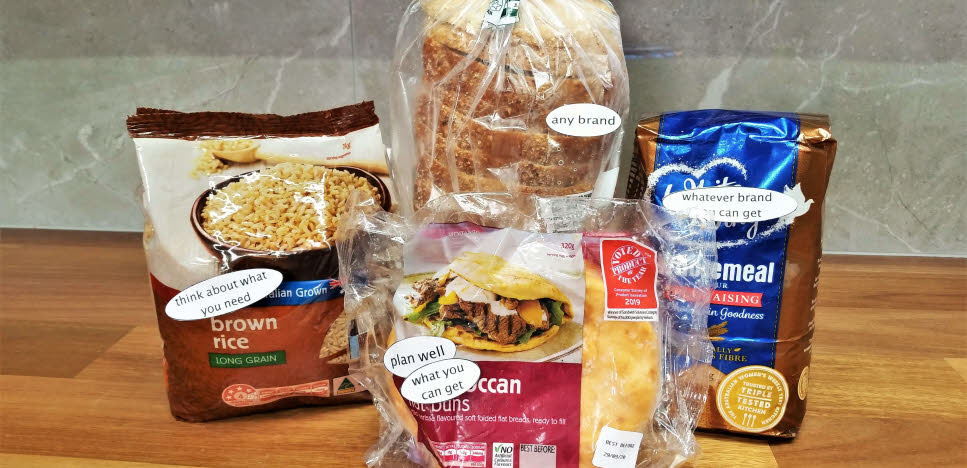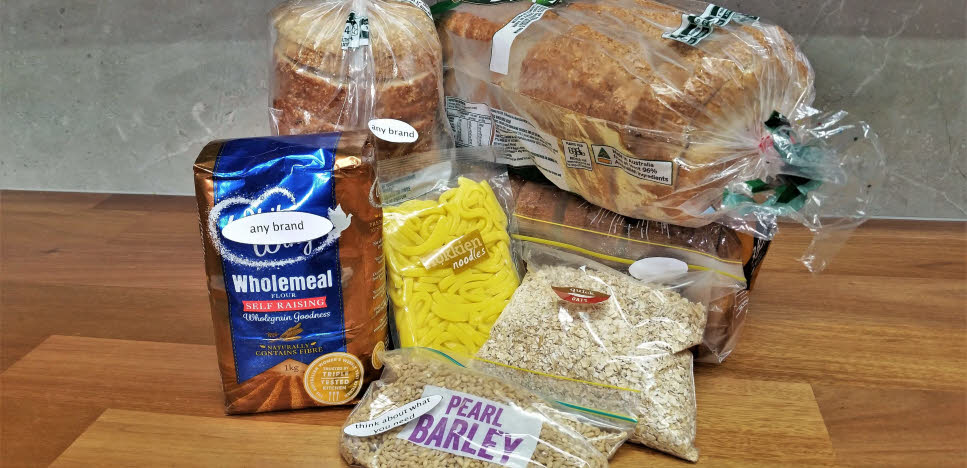Be ready for isolation due to Coronavirus with nutritious food choices
Preparing for Coronavirus self-isolation: BREAD and GRAIN foods
Tips on stocking bread and grain foods in readiness for isolation, whether by choice or need.
This is not a time to let your health slip so you need to be very flexible when shopping. This guide shows food swaps that help you keep your nutrition up.
If you are thrust into quarantine, lock down or isolation, you should not go to the shops to pick up groceries. You need to be ready for no shopping for two weeks unless home deliveries to your front gate are available. Even this may not be a good option because not all items on your grocery list will be available. You could be left very short on food.
Choose the best you can from what is left on the shelves. Some swaps may simply not be possible in your area but I have included them just in case they are.
Be prepared and assume you will not be able to shop during self-isolation.
Bread, grains and grain products
Fresh sliced loaf bread freezes well but is bulky. It takes up loads of room in the freezer so before you buy a few loaves, check whether you have enough freezer space. You may be better to buy and freeze flat breads and wraps because they take up less space.
Choose wholemeal when possible. If not, multi-grain. White is last on my list but better than no bread during these times. All commercial breads are enriched with vitamin folate and thiamin which is good for you.
Use a food processor or hand grate frozen bread ends into breadcrumbs. Use to coat fish and chicken or top savoury mince meals.
Cut bread loaf ends into cubes and make a bread and fruit pudding.
No fresh bread? Head for shelf-stable grains and grain products.
They keep well and are compact.
If you have a choice, choose brown rice, rolled oats, pearl barley and other wholegrain cereals, noodles and pasta. If you have no choice, consider white refined grain foods as fillers rather than a good source of nutrition during this time. You will be missing out on B vitamins and fibre. To top up on B vitamins, buy a black salty yeast spread (an Aussie favourite!) enriched with B vitamins or a commercial crunchy breakfast cereal. Most are enriched with B vitamins as well. To make up for lost fibre, buy extra oat or wheat bran to add in cooking.
Vacuum packed flat breads: Indian naan, wraps and flat breads, soft Mexican tortilla wraps
Dry grains: rice (prefer brown if you have a choice), pearl barley, quinoa, millet, wild rice
Pre-cooked microwave tubs and sachets of grains: rice (brown preferred), rice blended with other grains
Dry pasta: any shape or size (prefer fibre rich or wholegrain if available)
Dry noodle: any shape or size but avoid crunchy fried noodles
Soft noodle: vacuum sealed packs
Breakfast cereals: ideally choose wholegrain varieties
Rolled oats, rolled rice and instant oats: plain is great and can be used at breakfast, in casseroles and stews, and as a dessert crumble topping.
Flour: plain or self-raising wholemeal (preferred if you have a choice) and white flour. Buy baking powder if you can’t get self-raising flour; that way you can add it to plain flour to make your own. Buy instant dried yeast to make your own bread.
Wholegrain crackers. Leave behind white flour crackers and crackers with a high fat content.
Leave unusual flours and special grain products such as gluten-free flour, gluten-free pasta and low-carb breads for people who have a genuine medical need. They have far less choice and flexibility.
How much to buy, swap and serve for Covid-19 isolation?
Packets and cartons vary is size and you are at the mercy of what remains in the shop. These are approximate amounts that give you a guide when shopping.
Check your pantry before you shop for items in bulk. You may already have enough rice, pasta, noodle and grain hiding in the pantry somewhere.
I don’t usually talk about food in weights but when food is rationed at the shops, you need a better idea of how much to buy. Close enough is good enough at this stage.
By buying basic ingredients (rather than pre-made grain/pasta/rice dishes), you have the scope to cook a bigger variety of foods at home.
For one adult, aim for four to five serves daily (4 for women, 5 for men) where one serve equals 1 slice bread = 60 g flat breads = 40 g wheat flour = 40 g dry grain (rice, quinoa, barley) = 40 g dry pasta or dry noodle = 40 g breakfast cereal, rolled oats or semolina = 100 g soft noodles = 100 g pre-cooked rice = 40 g dry savoury wholegrain crackers
Whenever possible, select wholemeal wholegrain versions. For example, wholemeal flour, wholegrain cereal, pearl barley and brown rice.
Each one of these amounts is enough to last an adult 1 week, if you can not get any other variety of bread or grain:
- 1.1 to 1.4 kg dry rice, quinoa or other grain, dry pasta, dry noodle, breakfast cereal, rolled oats, OR
- 1.1 to 1.4 kg flour to make breads, scones, damper, sauces, puddings, OR
- 1.5 to 2 kg bread, sliced, flat or wraps, OR
- 2.8 to 3.5 kg soft noodles or pre-cooked microwave rice.
It is very likely that we will be able to get a wider variety of grain products so mix and adjust those amounts to make up 2 weeks worth of combined bread and grain foods.
Each of the following combo examples is enough to last 2 weeks for one adult*:
- 1 kg dry pearl barley/rice/other grain + 1 kg flour + 2 loaves bread (750 g)
- 1 kg flour + 500 g dry pasta/noodle + 1 kg dry breakfast cereal
- 4 loaves bread (1.5 kg) + 500 g dry oats + 500 g dry breakfast cereal + 300 g tortilla/flat breads + 200 g dry quinoa
- 1 kg microwave pre-cooked rice + 1.5 kg soft noodles + 500 g dry instant quick porridge oats + 1 kg wholegrain crackers
*based on 4½ serves daily
Adjust the proportions to suit your household preferences and what is available to buy. For example, there is no point stocking up on breakfast cereal if you are unlikely to eat it. Similarly, if you are not a home cook or baker, pre-cooked microwave rice may be a smarter buy than flour for you.
If you are used to popping into shop every few days and are not used to doing a main shop every week or so, these amounts sound a lot but they are not. Once spaced out across a fortnight, they are just enough.
By spreading the shop across dried, shelf-stable and fresh, rationing has less of an impact on the day you shop. It make take a couple of shopping trips to buy enough for a large household.
When choice is limited and food is rationed, close enough is good enough when it comes to amounts. We are at the mercy of our local shops and fellow shoppers.
Example of 2 weeks worth of bread and grain serves
Enough for one adult for two weeks when combined with all other food groups. Think about how these foods will work in your household.

Another example of bread serves for 2-weeks isolation
If freezer space is not an issue, loaves of bread are an easy practical and excellent choice. This might look a lot but if you are used to buying lunch out everyday, you might be surprised at how much bread and grains you usually eat.

